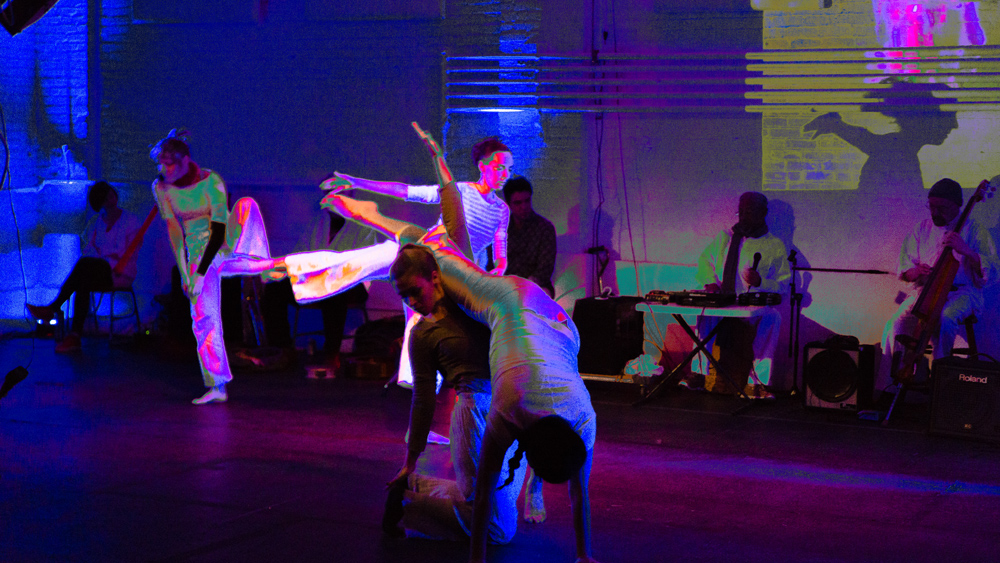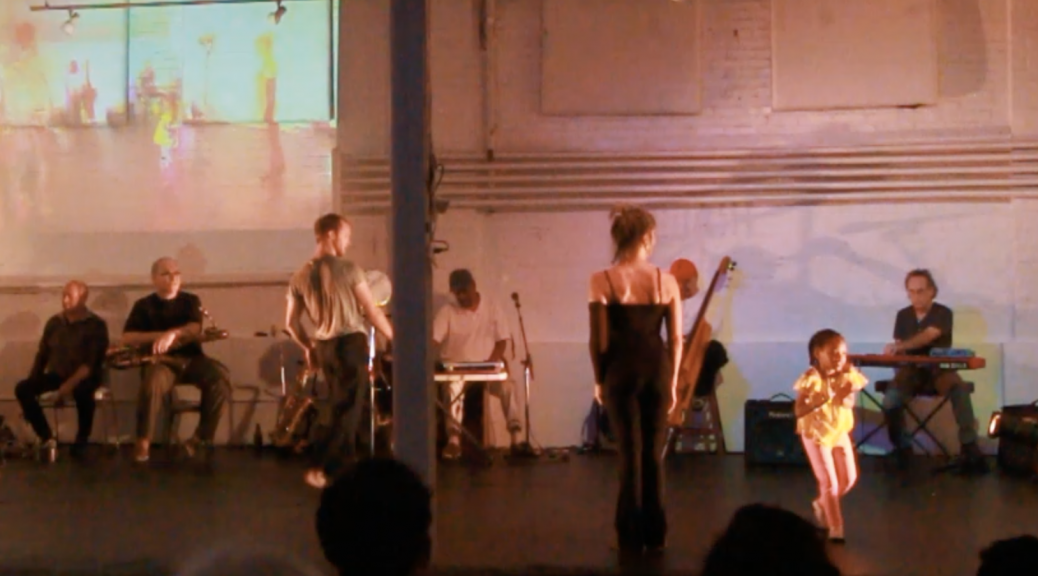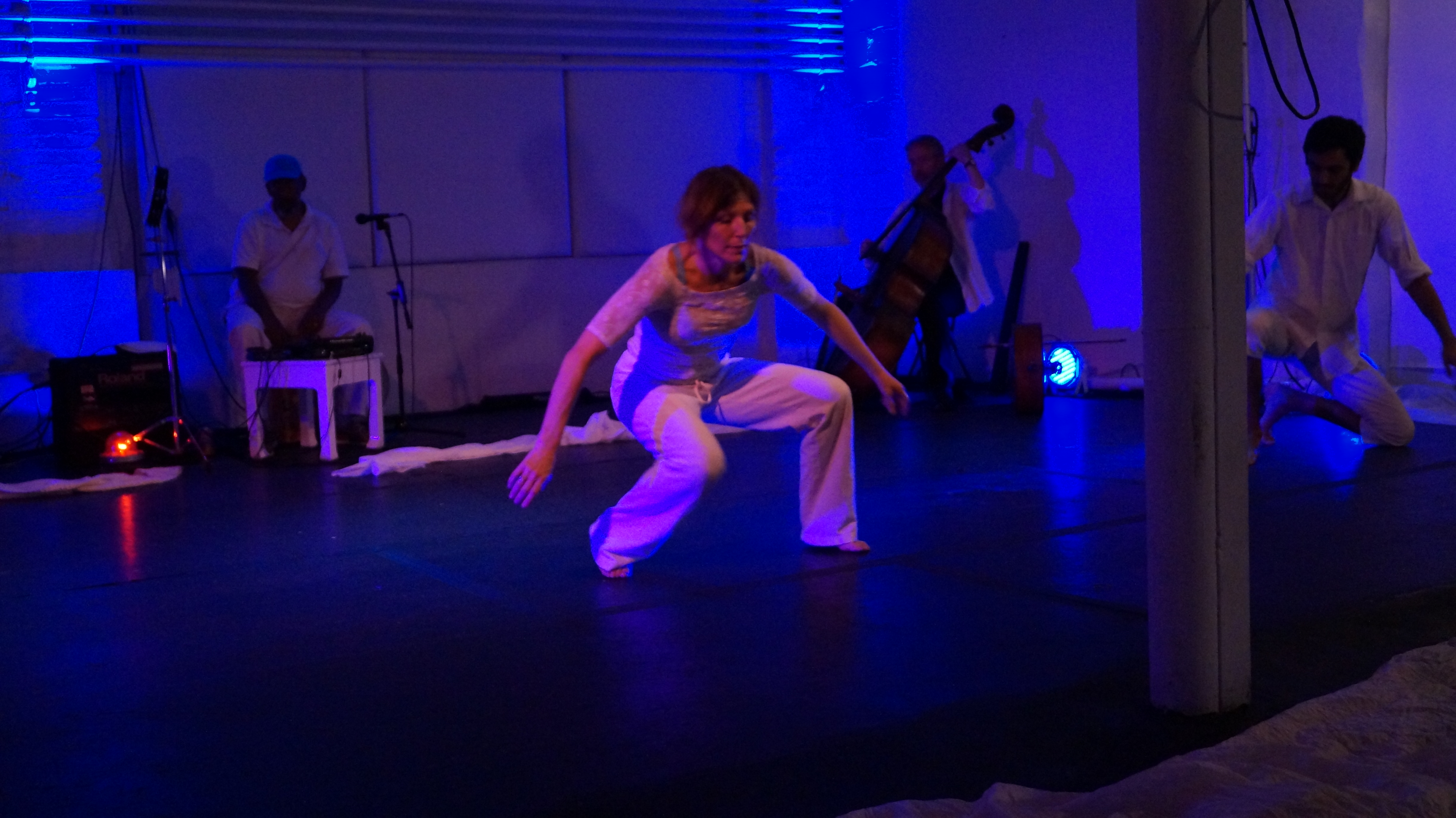Tabula Rasa answers a craving many artists have to cross-fertilize in an improvisational setting. The first part, from 6-8pm, is a video and art show, a retrospective of the past five years of staging this experiment. At 8pm the show begins, with seven old time jazz musicians, famous in the local scene, improvising while seven dancers also improvise, a painter paints live, a camera person’s live video is filtered and projected, in a stage-lit warehouse in the middle of Union Square, Somerville. In the second half, those from the audience like musicians (bring your instruments!), dancers, actors or performance artists of any kind are invited to join in the performance. Visual artists are invited to draw or paint at large tables at any time. Beer and wine will be served.
Category Archives: Commentary
Somerville Journal wrote about us
writes evocative stories for the Boston Globe and Somerville Journal. She happened to attend Thursday’s performance of ESCAPE, a Tabula Rasa Multidisciplinary Experiment, and called me later for an interview. Here is what she wrote:
Somerville artists create fully improvised performance |
Well-connected in the Boston creative circles, Musinsky assembled an accomplished crew of jazz musicians, many of whom are friends. Jazz musician and Musinsky’s neighbor Stan Strickland, who played saxophone on Thursday, opened for Aretha Franklin last year. Scott Getchell, who plays the trumpet, said that that improvising together is natural for Tabula Rasa’s musicians.
“It’s pure improvisation,” said Getchell. “But we’ve known each other for so long, that there are certain genres we can fall into.”
Throughout the performance, the motifs of blues, tango, and more classical music emerged. Musinsky compares dancing to live jazz as to being played like a marionette.
“We’re responding to the music and they’re responding to us,” she said.
To the side of the stage, Somerville artist Tamar Etingen was painting on a large poster. By intermission, the abstract strokes became figures of musicians and dancers.
“The musicians are playing, I’m painting–we’re all doing what we do,” said Etingen, who focuses on gelatin printmaking.
Joshua Rajman, who heard about ESCAPE from a friend, said that what appealed to him about unstructured and unscripted performance is the artist’s’ ability to take down any psychological barriers that might hold back the stream of consciousness. This kind of live discovery, he points out, takes courage.
While there is nothing new about improvisation in music and dance (the free jazz movement developed in the 1950s and 60s), for Rajman, it’s their synthesis on one stage that is unique about Musinsky’s work.
“The idea of each one cyclically inspiring each other is not something I’ve seen, at least in not such a publically viewable format,” said Rajman.
During the second act of the show, Musinsky invited everyone in the audience to join the dancers on the stage. But only a couple of uninhibited guests dared to come up.
Musinsky says that improvisation is shedding its reputation of being a trick “that you do when you don’t know what else to do.” With increased focus on mindfulness, contact improvisation practices have been gaining more popularity.
“You always have to be listening,” said Musinsky. “When you’re told what to do, you’re not as intensely focused on the people you’re [dancing] with.”
Origins and dreams
Tabula Rasa Multidisciplinary Experiment started as a celebration of a new event space opening up in Union Square, now called Warehouse XI. The project has since taken on a life of its own, as it fulfills a need, as expressed by many artists who have taken part, to work across the usual boundaries that divide the performing arts.
The improvisational and cross-disciplinary aspects of Tabula Rasa Multidisciplinary Experiments reflect interests that have emerged in me over many years as a performing artist. As a dance performer I missed the electricity of live music when dancing to recorded music. I always looked to the visual arts for inspiration, and have an amateur painting practice of my own. I have delved into video production, 2- and 3D animation, music, theater and other art forms, finding the disciplines draw important lessons and inspirations from one other. Improvisation has also become my favorite mode of performance, in part because of the difficulty of holding on to choreographic inspirations. I found it hard to trap movements inside repeatable phrases in a way that preserved the quality of the original improvisational research. I also felt choreography lacked the excitement of improvised movement, both in doing and watching. Structuring improvisations provides a compromise between overdetermining choreographic movement on the one hand and undisciplined, random movement for movement’ssake on the other.
A typical Tabula Rasa performance “experiment” invites audiences into the warehouse as finishing touches are made to the stage, so as not to hide any aspect of the process. Todd Sargent, the lighting designer, may focus a few lights, dancers and musicians warm up, and the artist sets up her onstage canvas and paints. When everyone has settled, the stage lights come on and the performance begins. We dance with and without planned structures, the musicians both follow and lead the dancers, and the artist paints the scene. A videographer shoots from a camera whose signal is fed into a computer program that filters and alters the video in various ways: delaying, thresholding, recoloring, cartooning or layering it, and then a projector shines the result on the wall over the action. The first half of the show unfolds. After a brief intermission, artists in the audience are invited to participate in the second half. Visual artists in the audience are provided tables and water with which to paint, and photographers and videographers have the freedom to roam.
Tabula Rasa Multidisciplinary Experiment has attracted artists and audiences with a keen interest in cross-discipline improvisation. I am pleased to have provided them and myself with the place and premise of Tabula Rasa. I still find myself searching for ways to rein the chaos that occasionally results when ten artists in a space each listens to his or her own muse. In 2017 my goal for Tabula Rasa Multidisciplinary Experiment is to continue the quest for the delicate balance between structure and spontaneity.
Unbelievable
Post election, everything seems to have shifted. On retrospect we look naïve. Whatever was happening was not what we thought, but the stage was set for this moment. Whatever you believe was the cause, it was already in motion.
Maybe that’s one reason it feels like a betrayal. As all the times you thought your love was at a meeting but he or she was with someone else, so all the times we thought our girl was winning, the sleazy guy was grabbing her from behind.
What do we do now? Hail Mary. Subpoena the election boards for paper ballots and installation cards. Petition the electors to vote their conscience.
Then sing to drown out the lies, dance to move out the demons, paint to show each other gratitude. Let’s prepare a show for the second weekend in January.



